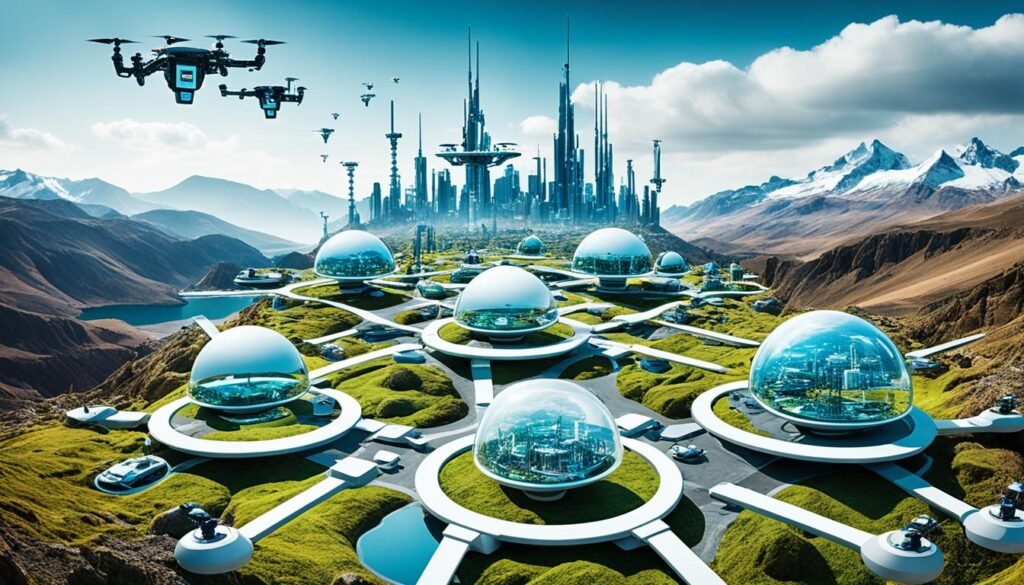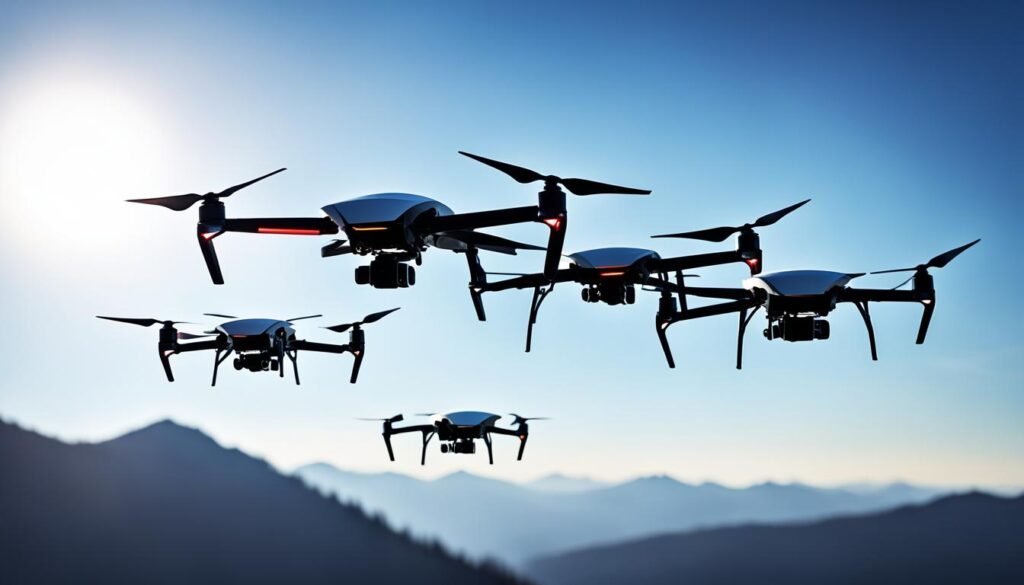In 2024, there were about 3.9 million operational robots worldwide. This number marks a new all-time high. A significant part of this boom is the advancement in robotics and automation technology. This progress is fueled by the integration of Artificial Intelligence (AI).
The use of generative AI is introducing innovative solutions. It helps robot manufacturers create easy-to-use programming interfaces. These interfaces allow users to control robots using everyday language, rather than complex code.
Predictive AI plays a key role too. It studies data from industrial robots in real-time. This analysis helps spot potential maintenance needs early. As a result, this approach promotes proactive predictive maintenance. It aims to cut down on unexpected equipment downtime.
Moreover, machine learning is optimizing how sets of robots work together. This strategy improves the efficiency and productivity of processes they handle.
Key Takeaways
- The global stock of operational robots hit a record high of 3.9 million units in 2024, powered by progress in robotics and automation technology.
- Increasingly, Artificial Intelligence (AI) is being merged into the field of robotics. It brings forth new solutions, like user-friendly programming with natural language.
- Predictive AI can scrutinize data to foresee maintenance requirements in robots. This proactive approach reduces downtime and its costs.
- By using machine learning, the performance of groups of robots can be fine-tuned. This tweak boosts efficiency and effectiveness.
- The robotics sector is experiencing a remarkable surge in innovation. Numerous exciting developments are influencing the future of automation.
Artificial Intelligence (AI) and Machine Learning
The blend of robotics and automation with Artificial Intelligence (AI) is getting stronger. The rise of generative AI is sparking new ideas. It lets robot manufacturers create easy-to-use systems. Workers can now guide robots using natural language. This is huge because it means anyone can operate a robot without needing to be a programming wiz.
Also Read: How Do Integrated Circuits Function In Electronic Devices?
Generative AI for Intuitive Robot Programming
Generative AI is changing how robots get programmed. It’s easier and more hands-on. With this tech, robots understand what we say or write. They don’t need special programming skills. This makes work faster and more efficient in factories and other places. More people can now use automation tools.
Predictive AI for Robotic Maintenance
Predictive AI is altering how we care for robots. It watches the robot’s health in real time. This helps predict and stop problems early. Doing this keeps the robots working. It saves money and makes work flow better. Thanks to AI and machine learning, we’re reaching new heights in making things run smoothly.
Also Read: How Do I Report A Cyber Security Incident?
Machine Learning for Process Optimization
Machine learning is changing how robots work in factories and more. It looks at how robots do their tasks. Then it finds ways to do these tasks even better. This means work is done more efficiently. It saves time and money. This smart use of robotics is pushing the industry forward.
Collaborative Robots (Cobots)
The world of robotics is changing fast. It’s moving towards human-robot collaboration. This change is thanks to cobots or collaborative robots. These robots work side by side with human workers. They make work more efficient, productive, and safe in factories.
Also Read: What Are The Latest Advancements In Digital Technology?
Expanding Applications in Welding
Cobots are now doing more in welding. They have high-tech sensors and vision systems. Thanks to these, they can weld complex things very well. They are fast and accurate. This technology makes the welds better. It also means human workers don’t have to do as much hard, repetitive work.
Mobile Manipulators for Material Handling
There’s a new thing called mobile manipulators in the cobot world. They move around like robots but can also grab things. This makes them great for moving stuff in factories. They go through tight spots and handle various materials. Using them helps factories work better, with less human effort.
New Competitors in Cobot Market
More and more, companies are making collaborative robots. Old and new names are joining in. This competition is pushing technology forward. Now cobots have better sensors, vision, and smart grippers. These improvements mean working with robots is safer and easier for everyone in factories.
Also Read: How Is Data Stored In Cloud Computing?
Mobile Manipulators
In the high-tech world of automation, mobile manipulators, nicknamed “MoMas,” are wowing us. They’re changing how we handle stuff in fields like cars, shipping, and space. These robots move like cars but grab things like people. This makes them perfect for making stuff in all kinds of ways.
Automating Material Handling Tasks
MoMas are the new heroes of moving stuff around. They take over the hard, boring jobs, letting people do the thinking stuff. These robots carry, pick, and set heavy things exactly right. This saves time and helps places run smoother.
Inspection and Maintenance Support
These robots are also great at checking and fixing things. With lots of eyes and senses, they look after equipment before it goes bad. They fix things early, so everything keeps running well. This cuts costs and keeps the work going.
Also Read: What Are The Latest Trends In Innovation Technology?
Collaborating with Human Workers
MoMas work well with people, helping out when there aren’t enough skilled hands. They do the hard, dull work, while people focus on what they do best. Together, they make places safer, run better, and get more done.
Digital Twins

Optimizing Robot Performance
Robots are now part of many factories. With digital twins, we can make these robots work even better. This means we can test and improve them without any risks. The result? Robots that are safer, more efficient, and cost less to make.
Bridging Digital and Physical Worlds
Digital twins connect what’s digital with what’s real. This link lets companies understand their work better. They can then take action to keep their systems working well, saving time and money.
Humanoid Robots
Robotics is moving forward fast with humanoid robots. These robots look a lot like us, with two arms and two legs. They fit well in places designed for people. This makes them a good choice for warehouses and factories.
Performing Wide Range of Tasks
Humanoid robots are special because they’re made like us. They can do many different jobs and fit into many spaces. They move and work like humans do. This is great for jobs in warehouses, factories, and more.
Potential for Mass Production
The tech behind humanoid robots is getting better. Soon, they might be made in big numbers. This could change a lot in warehouses and factories. But, how much it costs and if it’s worth it will decide their future. Manufacturers are excited. They want to see if these robots can make work better and faster.
Robotics
The robotics field is full of new ideas, especially in autonomous mobile robots (AMRs) and the use of artificial intelligence. These robots are changing how materials are handled in warehouses and beyond. They’re making tasks smart and automatic.
Autonomous Mobile Robots (AMRs)
In warehouses and logistic spots, AGVs and AMRs are taking on material handling jobs. These systems use sensors, AI, and computer vision to work on their own. They move products without needing humans. AMRs can see how much stock is left and move items across factory floors, speeding up work.
AMRs aren’t just used for moving items. They are also in hospitals and hotels for cleaning tasks and making contactless deliveries. Their abilities are boosting efficiency in many places, from warehouses to healthcare.
Intelligent Robotics with AI Integration
AI is a big part of making robots smarter. With AI, robots can now see their environment and act quickly. This makes them more helpful to people and able to do more things on their own.
Thanks to AI, robots can understand their surroundings better and work with humans. This is changing how businesses use automation. It’s helping them work smarter and be more accurate in various fields.
Internet of Robotic Things (IoRT)

The internet of things (IoT) mixes with our growing need for digitalization in the robotics world. Robots and smart sensors work together to gather real-time data. They use this data to make industrial processes and assets work better.
The Internet of Robotic Things (IoRT) brings together robotics, automation, and industrial automation. It uses the IoT for better digitalization and to improve how industries run. This leads to more efficiency and productivity.
Robot systems have sensors that gather important info on how they’re doing, what they need to stay in good shape, and on their operations. This info is then processed using today’s data analytics methods. With this, things like prepping for maintenance, making processes better, and using assets more effectively become possible. Being able to easily talk between robots, sensors, and the cloud is what makes IoRT work smoothly.
| Benefits of the Internet of Robotic Things (IoRT) |
|---|
| Increased automation and efficiency in industrial operations |
| Enhanced data collection and analytics for performance optimization |
| Improved predictive maintenance and asset utilization |
| Seamless connectivity between robotic systems and cloud platforms |
| Enablement of industrial automation and digitalization initiatives |
The mix of IoT and robotics is changing how we do automation and make choices using data. By using smart, connected robots, businesses can reach new heights of efficiency, productivity, and stay ahead in the market.
Robotic Cybersecurity

Robotics are now a big part of how things work in industries. It’s vital to keep these systems safe from cyber threats. Protecting them means we keep up with work and that everyone stays safe. With worries about cyber-attacks, it’s important to find ways to keep the systems safe from hacking.
Securing Robots from Cyber Threats
Today’s world, also known as Industry 4.0, relies a lot on robots and automation. This makes robotic cybersecurity very important. Companies must deal with the risks of using robots and smart tools connected to the internet. They need to take steps to protect against cyber threats that could stop work, mess up data, or harm people.
Good robotic cybersecurity plans need several steps. These include keeping software up-to-date, controlling who can get to the system, and separating the network. Also, they must be ready with a plan if something goes wrong. Doing these things helps avoid vulnerability and hacking. This keeps the robots working safely and well.
Drones

The robotics world is buzzing with the rapid growth in drones. These unmanned flying machines are being used in many different ways. They are key in last-mile delivery, transportation, surveillance, monitoring farmlands, and quick emergency response.
Drones change the game in the logistics field, especially in tough-to-reach areas. They fly seamlessly through obstacles, cutting down on delivery times. This ability helps in making supply chains more efficient and economical.
Not just for moving goods, drones have quickly become a major asset for keeping an eye on things. They offer a high-up look for keeping watch over important sites, noting environmental shifts, and helping out in emergencies. In farming, they’re used to monitor crops closely, ward off pests, and make watering more efficient.
As drone tech gets better, they’ll play even bigger roles in many areas. This includes logistics, farming, and public safety, offering smart solutions to various challenges. Drones are set to change the game in tech-driven ways.
| Application | Key Benefits |
|---|---|
| Delivery | Efficient last-mile delivery, access to remote areas |
| Surveillance | Comprehensive monitoring of critical infrastructure, enhanced emergency response |
| Agriculture | Precision crop monitoring, optimized irrigation, effective pest control |
| Emergency Response | Rapid deployment for disaster relief, search and rescue operations |
“Drones are changing logistics, transportation, and emergency response. They’re opening new doors for better efficiency, safety, and productivity everywhere.”
Adding drones to the robotics field shows our endless drive for new ideas and solutions. There’s a lot more coming in the world of flying tech. The future for robotics and automation is looking bright and innovative.
Robotics as a Service (RaaS)
Making robots and keeping them up is costly. It’s hard for many, especially small companies, to use robotics in their work. Robotics as a Service (RaaS) changes this. It’s a subscription-based model letting companies rent robots when needed. This makes it easy for them to use more automation as their needs grow.
Subscription-based Robot Utilization
The RaaS model means companies don’t need the big upfront costs or to deal with maintenance. They pay a subscription to use robot tech as they require. This model makes using robots more doable for a range of businesses, including small to medium-sized ones.
Cloud-based Robot Configuration Updates
Cloud-based robotics is crucial in RaaS. It helps providers to update robot setups quickly and boost their performance with real-time info. This means the robot systems can always be bettered, helping businesses use them more effectively and efficiently.
Also Read: 7 Latest Technology Trends Around the World
Conclusion
The newest robotics tech is changing how we work. It brings us automation, collaborative robots (cobots), and AI-powered systems. Artificial Intelligence (AI) and machine learning lead to amazing progress. They help with things like easy robot programming and better maintenance.
Robots we work with, called collaborative robots, do more now. They are in new jobs. There are also mobile manipulators for moving materials.
Digital twins connect virtual and real life. Humanoid robots will change things a lot. AMRs, intelligent robotics, and the Internet of Robotic Things (IoRT) also make work better.
As we face more cybersecurity problems, robotic cybersecurity is key. Robotics as a Service (RaaS) helps companies use robots easier.
All these changes make the future of work better. The robotics industry pushes ahead with new tech. It helps many areas work smarter and more affordably.
FAQs
Q: What are the latest advancements in robotics technology?
A: The robotics industry is rapidly evolving with advancements such as autonomous robots, programmable robots, motion planning, and cooperation between robots. Researchers are constantly working on improving the control system, motor technology, and navigation capabilities of robots. These advancements enable robots to perform a variety of tasks in industries like manufacturing, logistics, and automotive.
Q: How has robotics technology evolved in recent years?
A: In recent years, robotics technology has seen significant advancements in terms of autonomous robots, electronics, specialized robots for different industries, and the use of cameras for navigation and object recognition. These developments have paved the way for more efficient automation solutions and expanded applications in various sectors.
Q: What are the different types of robots being used in the industry?
A: The industry utilizes a variety of robots, including industrial robotics, programmable robots, autonomous robots, and robotic solutions specifically designed for logistics, manufacturing, and supply chain management. These robots are often specialized to perform particular tasks with precision and efficiency.
Q: How do robotics solutions contribute to automation in different sectors?
A: Robotics solutions play a vital role in automation across industries by offering efficient and flexible solutions for tasks that require precision, speed, and consistency. These solutions enable companies to streamline their operations, improve productivity, and meet the growing demands of the market.
Q: What is the role of robotics technology in shaping the future of industries?
A: Robotics technology is reshaping industries by providing innovative solutions for complex challenges. With advancements in science fiction becoming a reality, robots can now navigate unstructured environments, perform tasks autonomously, and interact with humans in collaborative work settings.
Q: How are robotics engineers and researchers contributing to the field?
A: Robotics engineers and researchers are at the forefront of developing cutting-edge technologies and solutions that push the boundaries of robotics capabilities. Their work involves designing control systems, programming robots, enhancing motion planning algorithms, and exploring new applications of robotics in diverse fields.
Q: What can we expect from robotics technology by the year 2024?
A: By 2024, robotics technology is projected to advance further with improved industrial robots, enhanced automation solutions, and a wider range of applications in industries such as logistics, manufacturing, and healthcare. Robots are expected to be more efficient, versatile, and capable of performing complex tasks with minimal human intervention.








